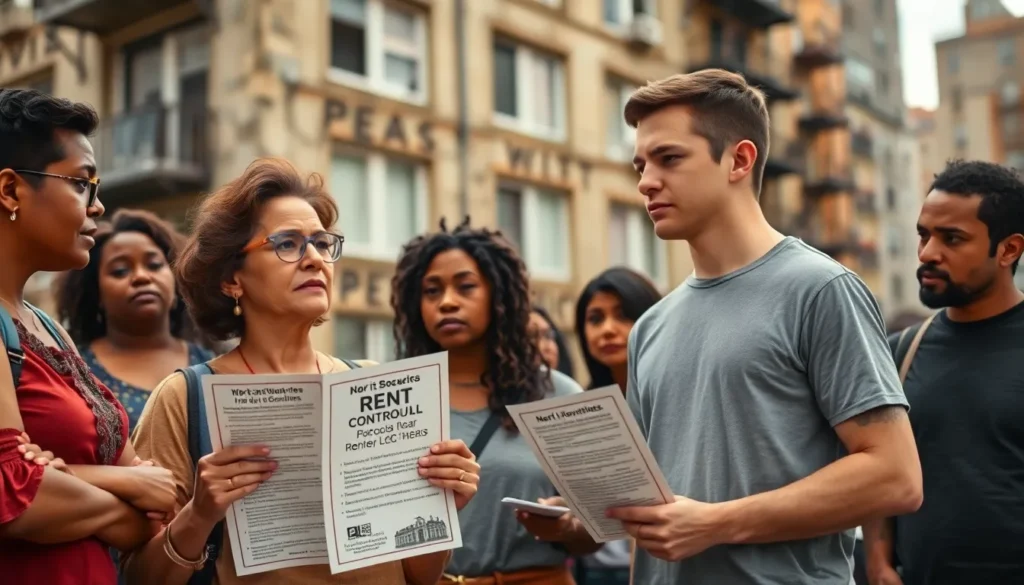Table of Contents
ToggleIn a world where rent prices can feel like they’re climbing Mount Everest, rent control regulations swoop in like a superhero—cape optional. These laws aim to keep housing affordable, ensuring that tenants aren’t forced to live in their parents’ basements just to make ends meet. But what’s the real deal with rent control?
Overview of Rent Control Regulations
Rent control regulations aim to create stability in housing markets by limiting rent increases and offering tenant protections. Many cities implement these laws to ensure affordability and prevent displacement. Various strategies exist under rent control, such as setting maximum rent increases or offering long-term leases.
Different regions enforce distinct rent control measures. For instance, California mandates a cap of 5% plus inflation for annual rent increases, while New York City has a complex system that allows for a range of increases based on building type and age. Each jurisdiction establishes specific guidelines to assess the permissible rent adjustments.
In addition to financial limits, rent control laws often include tenant rights. Protections typically encompass eviction processes and rights to renewal leases. Tenants may find reassurance in knowing they cannot be unfairly removed from their homes, fostering community stability.
Challenges accompany rent control regulations. Critics argue that such laws can discourage new housing developments and hinder maintenance of existing properties. Although intended to protect tenants, these measures sometimes lead to reduced investments from landlords.
Data consistently shows mixed outcomes related to rent control effects. Studies indicate that while some tenants benefit from stabilized rents, overall housing supply may decrease over time. Policymakers continue to analyze the balance between housing affordability and the health of rental markets, adjusting regulations as necessary.
History of Rent Control Regulations

Rent control regulations emerged in response to housing crises, aiming to stabilize vulnerable populations. These laws evolved through various socio-economic contexts, reflecting the need for affordable housing.
Origins and Development
World War I sparked the initial implementation of rent control in the United States. Governments enacted these regulations to combat housing shortages and rising rents. During the Great Depression, cities reinforced rent control to protect tenants from income loss. Such measures expanded further during World War II, as the boom in wartime labor exacerbated housing demands. As a result, local governments began establishing comprehensive rent control statutes. Each initiative laid the groundwork for ongoing reforms in housing policy focused on tenant protections.
Key Milestones
Several significant milestones mark the timeline of rent control regulations. The Housing Act of 1949 aimed to secure decent housing for all citizens, motivating states to adopt rent control measures. In 1972, significant reforms occurred with the introduction of the Rent Control Law in New York City, shaping future legislation. Various states followed suit throughout the 1980s and 1990s, enacting their own laws. More recently, 2019 saw California implement statewide rent control, capping annual increases at 5% plus inflation. Each milestone illustrates shifting priorities in housing and the evolving landscape of tenant protection.
Types of Rent Control Regulations
Rent control regulations encompass various strategies to ensure affordable housing and tenant protection. Understanding these types helps clarify how different regions address the challenges of rising rent.
Price Ceilings
Price ceilings represent one way to limit rent increases, establishing maximum allowable rent levels. Various jurisdictions implement these ceilings to prevent landlords from excessively raising rents. For example, California mandates a 5% increase plus inflation per year, providing landlords with some flexibility while protecting tenants. In contrast, New York City’s price ceilings vary significantly based on building age and type, creating a complex framework aimed at safeguarding different tenant populations. Price ceilings help reduce immediate financial pressures on renters, fostering stability in housing markets.
Rent Stabilization
Rent stabilization acts as a specific form of rent control that combines both limits on rent increases and tenant rights. In many cities, landlords can increase rents only by a predetermined percentage, typically less than the overall inflation rate. This system exists in New York City, where primary residence tenants benefit from substantial long-term protections against evictions and renewal rights. Different cities may adopt various formulas to set stabilization rates, reflecting local economic conditions. Rent stabilization directly impacts tenant retention and housing security, contributing to community stability in increasingly competitive rental markets.
Impact of Rent Control Regulations
Rent control regulations significantly influence various stakeholders in the housing market. Examining their effects reveals how these laws shape experiences for tenants, landlords, and the overall market landscape.
On Tenants
Tenants often benefit from the financial security provided by rent control regulations. Stabilized rent prices allow individuals and families to budget effectively, reducing the risk of displacement. Protections against eviction contribute to tenant confidence, fostering community ties and stability. Access to long-term leases enhances housing security over time. Additionally, regulations can lead to improved living conditions, with some laws mandating maintenance responsibilities for landlords. This combination ultimately promotes a sense of permanence for tenants in their living situations.
On Landlords
Landlords face unique challenges due to rent control regulations. These laws typically limit annual rent increases, impacting revenue potential. Lower profit margins may discourage some landlords from maintaining properties, resulting in deferred maintenance or deterioration. Access to financing can become more complicated, as banks may perceive rent-regulated properties as higher-risk investments. Additionally, landlords must navigate legal complexities surrounding tenant rights and eviction procedures. These factors collectively inform landlords’ willingness to invest in new developments or improvements within rent-controlled areas.
On Housing Market
The housing market experiences mixed effects from rent control regulations. While these laws aim to enhance affordability, they may inadvertently decrease housing supply by discouraging new developments. Investment in rental properties can diminish as developers weigh potential profits against regulatory constraints. Housing shortages may result, limiting options for both renters and potential buyers. Market dynamics also shift, as demand for rent-controlled units often exceeds supply. Data indicates that long-term effects may include reduced overall housing availability, complicating the balance between tenant protection and market health.
Challenges and Controversies
Rent control regulations create multiple challenges and controversies affecting housing markets and communities.
Economic Implications
Economic implications are significant when examining rent control regulations. Critics argue that these regulations deter new housing developments, limiting supply. Long-term effects can lead to increased demand for existing rentals. Reduced investment from landlords can result in neglect of property maintenance. Furthermore, stability may cause landlords to exit the market, reducing available rental units. Various studies suggest that while existing tenants benefit from controlled rents, the overall housing supply declines. Influencing these market dynamics, policymakers face a balancing act between tenant protections and a healthy housing market.
Social Equity Concerns
Social equity concerns arise with the implementation of rent control regulations. While these laws aim to support low-income tenants, they may inadvertently favor long-term residents over newcomers. Access to affordable housing becomes a challenge for those entering the market. Landlords often prioritize tenants they perceive as stable, sometimes neglecting the needs of vulnerable populations. Moreover, critics highlight that some high-income renters can take advantage of these stable rent prices. Addressing these inequities requires careful consideration of policy adjustments to promote inclusivity while protecting tenant rights.
Case Studies
Case studies of rent control regulations illustrate varying outcomes across different regions. Successful implementations often demonstrate how effective strategies can stabilize housing markets.
Successful Implementations
California showcases a successful implementation of rent control with its annual rent increase cap of 5% plus inflation. This approach has provided tenants with predictable rent levels, allowing them to budget effectively. Evidence indicates that many renters have experienced greater housing security under this framework. New York City’s rent stabilization laws also serve as a positive example, protecting thousands of long-term tenants. Tenants report lower eviction rates and better community stability attributed to these regulations.
Failed Policies
Some rent control policies have not achieved their intended outcomes. In the 1970s, several U.S. cities attempted aggressive rent control measures that led to significant declines in housing quality. Landlords often cited insufficient revenue to maintain properties, resulting in neglected buildings. Additionally, San Francisco’s rent control program, while designed to support tenants, faced criticism for exacerbating housing shortages. High-income renters benefited disproportionately, further complicating the access to affordable housing for lower-income families. These failed policies illustrate the challenges inherent in balancing tenant protection with housing supply needs.
Rent control regulations play a crucial role in shaping housing markets and protecting tenants. By limiting rent increases and ensuring tenant rights, these laws foster community stability and provide financial relief. However the complexities surrounding these regulations present ongoing challenges. Critics raise valid concerns about potential negative impacts on housing supply and property maintenance.
As policymakers continue to navigate this intricate landscape they must balance the need for affordable housing with the health of rental markets. The evolution of rent control demonstrates the importance of adaptable strategies that respond to the diverse needs of communities. Ultimately the future of rent control will depend on finding solutions that promote inclusivity while safeguarding tenant protections.





